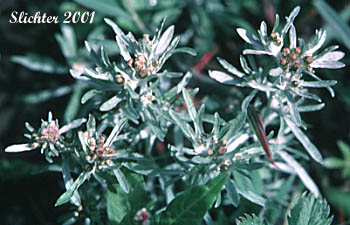

Marsh cudweed is an opportunistic, weedy species which may grow either as an annual or perennial. The stems are simple or branched and rise from 3-25 cm high. The stems are covered with white or gray woolly hairs. The leaves alternate along the stems and range from nearly hairless to covered with woolly hairs. Individual leaves are linear to lance-shaped and light blue-green in coloration. The leaves range from 8-50 mm long and 1-4 mm wide.
The flower heads are grouped in small, leafy-bracted clusters at the tips of the stems. The involucral bracts are papery with pale green bases and greenish to dark brown tips. The bases of the involucres are imbedded in brownish woolly hairs. The disk flowers are whitish and about 2.5 mm long. The outer 94-108 outer flowers are female while the inner 5-7 flowers are functionally male (they have both male and female reproductive organs).
In appearance, marsh cudweed is similar to lowland cudweed, Gnaphalium palustre. However the latter plant has wider oblong-lance-shaped to spatulate leaves and herbage which is more loosely woolly.
Marsh cudweed is an aromatic plant which is sometimes used in dried flower arrangements.
Marsh cudweed is a common plant of low moist places such as ditches, roadsides, gardens, and poorly drained disturbed places. They are common pioneers of puddles, seasonal ponds and moist ground.
A weedy import from Europe, marsh cudweed is now commonly found throughout the eastern United States. In the Pacific Northwest, it has a wide distribution but is most common in the lowlands of the Puget Trough and near the Columbia River.